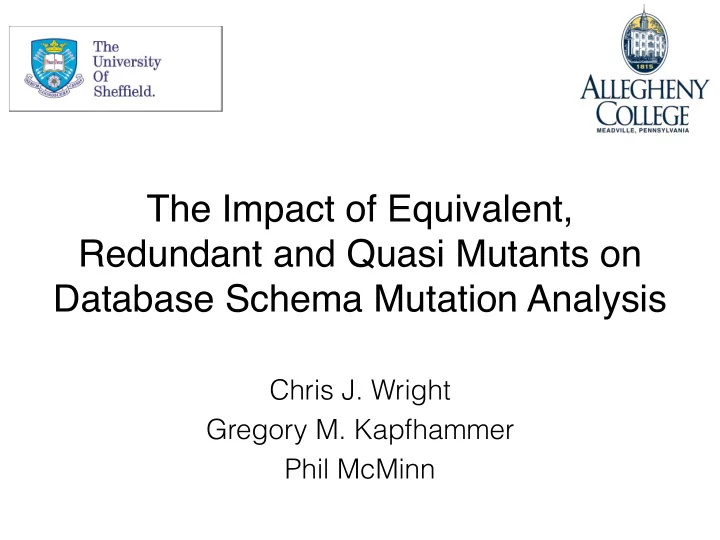

Behavioural Equivalence Patterns • NOT NULL on PRIMARY KEY columns • Implicit NOT NULL on PRIMARY KEY • (Only PostgreSQL and HyperSQL)
Behavioural Equivalence Patterns • NOT NULL on PRIMARY KEY columns
Behavioural Equivalence Patterns • NOT NULL on PRIMARY KEY columns 1 CREATE TABLE T ( 1 CREATE TABLE T ( 2 A CHAR , 2 A CHAR NOT NULL, 3 PRIMARY KEY (A) 3 PRIMARY KEY (A) 4 ); 4 );
Behavioural Equivalence Patterns
Behavioural Equivalence Patterns • UNIQUE and PRIMARY KEY with shared columns
Behavioural Equivalence Patterns • UNIQUE and PRIMARY KEY with shared columns 1 CREATE TABLE T ( 1 CREATE TABLE T ( 2 A CHAR , 2 A CHAR , 3 PRIMARY KEY (A), 3 PRIMARY KEY (A) 4 UNIQUE (A) 4 ); 5 );
Quasi-mutants
Quasi-mutants • Operators produce DBMS-agnostic mutants
Quasi-mutants • Operators produce DBMS-agnostic mutants • Some DBMSs have implicit constraints
Quasi-mutants • Operators produce DBMS-agnostic mutants • Some DBMSs have implicit constraints • Valid for some DBMSs, invalid for others ✗ ✗ SQLite ✓ PostgreSQL HyperSQL
Quasi-mutants • Operators produce DBMS-agnostic mutants • Some DBMSs have implicit constraints • Valid for some DBMSs, invalid for others ✗ ✗ SQLite ✓ PostgreSQL HyperSQL •
Quasi-mutants ✗ HyperSQL ✗ SQLite ✓ PostgreSQL
Quasi-mutants • Cannot adversely affect mutation score ✗ HyperSQL ✗ SQLite ✓ PostgreSQL
Quasi-mutants • Cannot adversely affect mutation score • …but may preclude some optimisations ✗ HyperSQL ✗ SQLite ✓ PostgreSQL
Quasi-mutants • Cannot adversely affect mutation score • …but may preclude some optimisations • Remove when DBMS will ‘reject’ them SQLite ✓ ✗ HyperSQL ✗ PostgreSQL
Types of Quasi-mutants
Types of Quasi-mutants • Representative example
Types of Quasi-mutants • Representative example • DBMS: PostgreSQL, HyperSQL
Recommend
More recommend